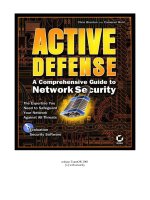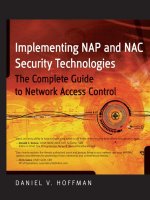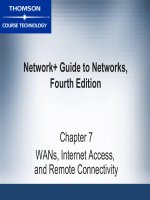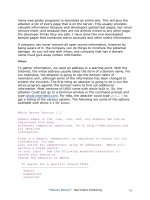Lecture Security + Guide to Network Security Fundamentals (2th edition) - Chapter 7: Protecting advanced communications
Bạn đang xem bản rút gọn của tài liệu. Xem và tải ngay bản đầy đủ của tài liệu tại đây (1.35 MB, 54 trang )
Chapter 7: Protecting Advanced
Communications
Security+ Guide to Network Security
Fundamentals
Second Edition
Objectives
• Harden File Transfer Protocol (FTP)
• Secure remote access
• Protect directory services
• Secure digital cellular telephony
• Harden wireless local area networks (WLAN)
Hardening File Transfer
Protocol (FTP)
• Three ways to work with FTP:
– Web browser
– FTP client
– Command line
• FTP servers can be configured to allow
unauthenticated users to transfer files (called
anonymous FTP or blind FTP)
Hardening File Transfer Protocol
(FTP) (continued)
• Vulnerabilities associated with using FTP
– FTP does not use encryption
– Files being transferred by FTP are vulnerable to manin-the-middle attacks
• Use secure FTP to reduce risk of attack
– Secure FTP is a term used by vendors to describe
encrypting FTP transmissions
• Most secure FTP products use Secure Socket Layers
(SSL) to perform the encryption
Hardening File Transfer Protocol
(FTP) (continued)
• FTP active mode
– Client connects from any random port >1,024 (PORT
N) to FTP server’s command port, port 21 (Step 1)
– Client starts listening to PORT N+1 and sends the FTP
command PORT N+1 to the FTP server
• FTP passive mode
– Client initiates both connections to server
– When opening an FTP connection, client opens two
local random unprivileged ports >1,024
Hardening File Transfer Protocol
(FTP) (continued)
Secure Remote Access
• Windows NT includes User Manager to allow dial-in
access, while Windows 2003 uses Computer
Management for Workgroup access and Active
Directory for configuring access to the domain
• Windows 2003 Remote Access Policies can lock
down a remote access system to ensure that only
those intended to have access are actually granted it
Tunneling Protocols
• Tunneling: technique of encapsulating one packet of
data within another type to create a secure link of
transportation
Tunneling Protocols (continued)
Point-to-Point Tunneling
Protocol (PPTP)
• Most widely deployed tunneling protocol
• Connection is based on the Point-to-Point Protocol
(PPP), widely used protocol for establishing
connections over a serial line or dial-up connection
between two points
• Client connects to a network access server (NAS) to
initiate connection
• Extension to PPTP is Link Control Protocol (LCP),
which establishes, configures, and tests the
connection
Point-to-Point Tunneling Protocol
(PPTP) (continued)
Layer 2 Tunneling Protocol (L2TP)
• Represents a merging of features of PPTP with
Cisco’s Layer 2 Forwarding Protocol (L2F), which
itself was originally designed to address some of the
weaknesses of PPTP
• Unlike PPTP, which is primarily implemented as
software on a client computer, L2TP can also be
found on devices such as routers
Authentication Technologies
• Authenticating a transmission to ensure that it comes
from an approved sender can provide an increased
level of security for remote access users
IEEE 802.1x
• Based on a standard established by the Institute for
Electrical and Electronic Engineers (IEEE)
• Gaining wide-spread popularity
• Provides an authentication framework for 802-based
LANs (Ethernet, Token Ring, wireless LANs)
• Uses port-based authentication mechanisms
– Switch denies access to anyone other than an
authorized user attempting to connect to the network
through that port
IEEE 802.1x (continued)
• Network supporting the 802.1x protocol consists of
three elements:
– Supplicant: client device, such as a desktop computer
or personal digital assistant (PDA), which requires
secure network access
– Authenticator: serves as an intermediary device
between supplicant and authentication server
– Authentication server: receives request from supplicant
through authenticator
IEEE 802.1x (continued)
IEEE 802.1x (continued)
• Several variations of EAP can be used with 802.1x:
– EAP-Transport Layer Security (EAP-TLS)
– Lightweight EAP (LEAP)
– EAP-Tunneled TLS (EAP-TTLS)
– Protected EAP (PEAP)
– Flexible Authentication via Secure Tunneling (FAST)
Remote Authentication Dial-In User
Service (RADIUS)
• Originally defined to enable centralized authentication
and access control and PPP sessions
• Requests are forwarded to a single RADIUS server
• Supports authentication, authorization, and auditing
functions
• After connection is made, RADIUS server adds an
accounting record to its log and acknowledges the
request
• Allows company to maintain user profiles in a central
database that all remote servers can share
Terminal Access Control Access
Control System (TACACS+)
• Industry standard protocol specification that forwards
username and password information to a centralized
server
• Whereas communication between a NAS and a
TACACS+ server is encrypted, communication
between a client and a NAS is not
Secure Transmission Protocols
• PPTP and L2TP provide a secure mechanism for
preventing eavesdroppers from viewing
transmissions
Secure Shell (SSH)
• One of the primary goals of the ARPANET (which
became today’s Internet) was remote access
• SSH is a UNIX-based command interface and
protocol for securely accessing a remote computer
• Suite of three utilities—slogin, ssh, and scp
• Can protect against:
– IP spoofing
– DNS spoofing
– Intercepting information
Secure Shell (SSH) (continued)
IP Security (IPSec)
• Different security tools function at different layers of
the Open System Interconnection (OSI) model
• Secure/Multipurpose Internet Mail Extensions
(S/MIME) and Pretty Good Privacy (PGP) operate at
the Application layer
• Kerberos functions at the Session layer
IP Security (IPSec) (continued)
IP Security (IPSec) (continued)
• IPSec is a set of protocols developed to support the
secure exchange of packets
• Considered to be a transparent security protocol
• Transparent to applications, users, and software
• Provides three areas of protection that correspond to
three IPSec protocols:
– Authentication
– Confidentiality
– Key management









